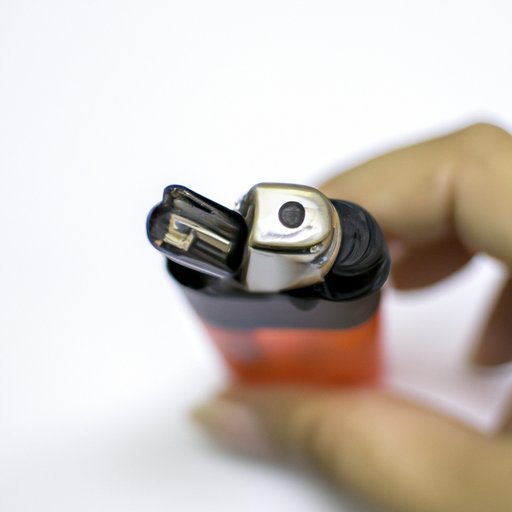
Introduction
Are you tired of running out of lighter fluid or constantly buying new lighters? Refilling a butane lighter is an easy and cost-effective solution. However, it’s essential to fill it correctly and take safety precautions while doing so. In this article, we’ll provide a step-by-step guide on how to fill a butane lighter, compare it with other types of lighters, give safety tips, maintain it and troubleshoot any potential issues.
Step-by-Step Guide on How to Fill a Butane Lighter
To fill a butane lighter, you need butane fuel and an empty lighter. Here’s a step-by-step guide to refilling your butane lighter:
- Before refilling your lighter, make sure it’s entirely empty.
- Turn the lighter upside down and locate the refill valve on the bottom.
- Use the butane fuel nozzle to place it firmly on the refill valve of the lighter. Make sure that the nozzle and valve are correctly aligned.
- While holding the lighter and can firmly together, press down on the nozzle for several seconds. You’ll hear the sound of the fuel being transferred to the lighter’s tank.
- Stop refilling the lighter when it’s approximately 80% full and wait for 2-3 minutes before using it.
Keep in mind that the method may vary slightly for different lighters. Double-check your lighter’s manual before following these steps, and if there’s any gas leakage while filling, stop immediately, and close the valve.
Here are some tips to efficiently fill up a butane lighter:
- Use a high-quality butane fuel that’s 5 times refined and doesn’t contain any impurities like oil or moisture.
- Use a nozzle adapter to ensure a tight fit and reduce wastage or spillage.
- Make sure you hold the butane fuel can and lighter horizontally during refilling to avoid air entering the tank or the nozzle getting blocked.
- Allow the butane fuel to come to room temperature before use for perfect flame results.
Video Tutorial for Filling a Butane Lighter
While the step-by-step guide is helpful, sometimes watching a video can provide a better understanding of the process. Here’s a YouTube video to show you how to fill a butane lighter efficiently:
It’s crucial to follow the instructions and not rush through the process. Common mistakes include overfilling the lighter, holding it vertically during refilling, or not waiting for 2-3 minutes before use.
Comparison with other types of lighters
Butane lighters are a popular choice because they are easy to fill, affordable, widely available and produce a strong, consistent flame that is ideal for lighting cigarettes, pipes and candles. They are also more efficient for frequent and outdoor use. Here’s a comparison between butane lighters and other types of lighters:
| Types of Lighters | Advantages | Disadvantages |
|---|---|---|
| Butane lighters | Easy to refill, affordable, durable, consistent flame, ideal for frequent and outdoor use | Can be volatile if dropped, not windproof |
| Zippo Lighters | Windproof, can be used in any weather condition, durable, refillable | Require lighter fluid and flints, needs frequent maintenance, can dry out and evaporate quickly |
| Disposable Lighters | Portable, variety of designs, affordable, easy to use | Not environmentally friendly, not windproof, need to be replaced frequently |
While different types of lighters have their advantages and disadvantages, butane lighters are an excellent choice for frequent use and outdoor activities.
Safety Tips for Using a Butane Lighter
When it comes to using a butane lighter, safety should be a top priority. Here are some tips to follow:
- Only use high-quality butane fuel and never use gasoline or other flammable liquids
- Make sure there are no open flames or sparks in the surrounding area when refilling the lighter
- Do not smoke while refilling the lighter or immediately after using it
- Ensure that children are not around while filling or using the lighter
- Do not leave the lighter in direct sunlight or in the car, especially during hot weather as it can cause the fuel to expand and potentially become volatile
- When using the lighter, hold it away from your face and body and do not touch the burning end
By following these tips, users can minimize the risk of accidents while using a butane lighter.
Maintaining a Butane Lighter
Maintaining a butane lighter is essential to get the most out of it. Here are some tips on how to care for your lighter:
- Periodically clean your lighter with a soft cloth and avoid using water or cleaning solutions that may damage it
- Avoid dropping the lighter, as this can cause damage to the ignition system or casing
- Check the fuel level regularly to refill it before running out
- If the lighter doesn’t ignite, check if the butane container has the fuel, valve isn’t blocked, and the ignition system isn’t damaged
If you notice any sign of corrosion, leaks, or unusual flames, it may be time to seek professional help.
Troubleshooting Issues with Butane Lighters
While refilling and using a butane lighter is relatively easy, it can encounter issues that require troubleshooting. Here are some common issues and tips to solve them:
- Low flame intensity: Check if there’s enough fuel in the lighter or it needs to be refilled. Clean the ignition system or check the adjuster for the flame intensity.
- Leakage: Check the valve and nozzle for any cracks or damage. Tighten the seal by using a nozzle adapter, or visit a repair shop if needed.
- Won’t ignite: Check if there’s enough fuel, valve isn’t blocked and isn’t damaged, and ignition system is functioning correctly. If not, use a pin to clean the nozzle or seek professional help.
Conclusion
By following this step-by-step guide on how to fill a butane lighter, you can enjoy a cost-effective and efficient lighting solution. Always remember to follow safety precautions, maintain, and troubleshoot any potential issues.




